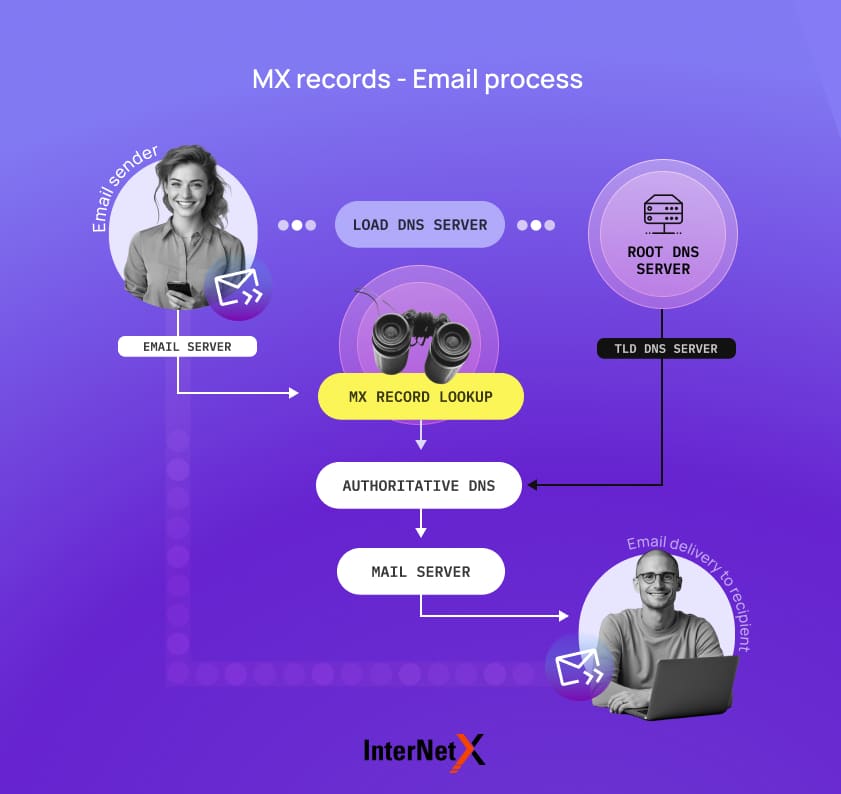
MX records | DNS

Navigate the complexities of MX records and optimize DNS settings for fail-safe email success.
Published by

Simone Catania
Date
We all know the critical role of the Domain Name System (DNS) translating human-friendly domain names into IP addresses. This process ensures you are navigated where you want to go when you type a website address into your browser. However, DNS is not just about guiding web browsers; it plays a crucial role in various other communication services, especially email.
Mail Exchange (MX) records hold a special place among the DNS record types. They are pivotal in ensuring emails sent to your domain reach their destination efficiently and reliably. Given their critical role, understanding MX records is paramount for anyone managing domain email services.
Whether you’re a business owner, IT professional, domain manager or just starting with managing email servers, this article will provide valuable insights into how MX records function and why they are crucial for successful email communication.
What is an MX record?
An MX record, short for Mail Exchange Record, is an essential type of DNS record defined in RFC 974 that specifies the mail server responsible for receiving email messages on behalf of a domain. The primary purpose of MX records is to facilitate the smooth routing and delivery of emails across the internet. Without MX records, there would be no reliable method to determine which server handles emails for a particular domain, leading to undelivered messages and communication breakdowns.
MX records play a pivotal role in maintaining the efficacy and reliability of secure email communication globally by clearly defining the route that an email should take from its origin to its final destination.
Bridging domain names and email communications
The relationship between domain names, emails, and MX records is foundational to how online communication functions. A domain name serves as a memorable online address, akin to a digital street address for a business or individual. When an email is addressed to a specific domain, the MX records are like the directions that tell the postal service where to deliver mail within that address.
Without these records, there would be no way to distinguish which email server within the vast internet network is designated to receive and manage email correspondence for a domain. As part of the domain’s DNS settings, MX records are the crucial link that ensures the message reaches the correct destination when someone sends an email to an address at a particular domain. They map the domain name to the email servers, guiding the flow of communication seamlessly from sender to recipient.

How do MX records work?
MX records guide emails through the DNS to the intended recipient’s email server based on specified priorities and server addresses.
Each Mail Exchange Record contains two key pieces of information: priority (also known as preference) and the mail server address.
-> The priority of an MX record helps determine which server should be tried first when multiple mail servers are listed for a single domain. The server with the lowest numerical priority is attempted first. A lower number signifies a higher priority, with the primary server typically set as ‘0’ or ’10’. This system allows domain administrators to set up primary, secondary and subsequent backup servers to ensure continuous mail service, even if one server goes down.
-> The mail server address in an MX record points to the hostname of a server capable of receiving emails on behalf of the domain. This is not the IP address directly.
| Priority | Domain | TTL | Mail Server | Purpose |
| 10 | example.com | 3600 | mailserver1.example.com. | Primary server for handling incoming emails. |
| 20 | example.com | 3600 | mailserver2.example.com. | Backup server if the primary server is unreachable. |
When an email is sent, the DNS resolves the domain of the recipient’s email address to a list of MX records sorted by priority. The email is first directed to the server with the highest preference (lowest priority number). If that server is unavailable, the next server with the following lowest priority number is tried and so forth. In practice, email servers will attempt to send emails to mailserver1.example.com first. If that server can’t be reached, emails will then be sent to mailserver2.example.com.
This mechanism ensures that the email finds the most efficient and available route to its destination.
Understanding MX records and the email delivery process

- Email sent: The sender starts by sending an email to the recipient’s address (e.g., recipient@example.com).
- Local DNS resolution: The email server of the sender sends a request to the local DNS resolver to find the mail server address of the recipient’s domain (MX record for example.com).
- Root and TLD DNS resolution: If the local DNS resolver does not have the information in its cache, it goes first to the root DNS server and then to the TLD (e.g., .com) server to find the authoritative DNS server for the domain.
- Authoritative DNS server: The authoritative DNS server for the domain, which holds the actual records, including the domain’s MX record, is queried.
- Receiving the MX record: The sender’s mail server receives the MX record information, which indicates the destination mail server responsible for receiving emails for that domain.
- Email delivery: The email is forwarded to the mail server indicated by the MX record, which will then deliver the email to the recipient’s mailbox.
This is a simplified example of the process of the role of the MX record. In reality, the delivery of an email may involve additional verification and authentication steps to ensure security and reliability.
Best practices for managing MX Records
Managing MX records is crucial for ensuring reliable and secure email communication.
-> One best practice is to conduct regular reviews and updates of MX records as part of broader DNS management routines. This includes verifying that the records point to the correct mail servers, confirming that backup servers are up and operational and adjusting TTL values based on how frequently changes are expected.
-> Maintaining accurate and precise documentation of all configuration settings is also advisable for troubleshooting and compliance purposes.
Misconfigured MX records can lead to a variety of serious email delivery issues. Incorrect priority settings could result in emails being routed to a less capable server, potentially overwhelming it and causing delays or message loss.
Pointing MX records to an incorrect server can result in the non-delivery of emails, which not only disrupts communication but could also lead to missed business opportunities or critical information being overlooked. In some cases, misconfiguration could expose emails to interception or other security risks, particularly if email traffic is inadvertently directed through insecure or compromised servers.
Vigilance in setting up and maintaining MX records is essential to avoid disruptions and protect against security vulnerabilities, ensuring that email remains a reliable communication tool for personal or business use.
Common MX record configurations
MX record configurations can vary based on a domain’s needs, particularly in terms of reliability and load management.
-> Different priorities: A typical configuration has multiple MX records set with varying priorities for failover purposes. This means that if the primary mail server (with the lowest priority number, such as ’10’) is unavailable due to maintenance or an outage, emails will automatically be routed to the next available server with a higher priority number (like ’20’). This setup ensures that email functionality remains intact even if one server fails.
-> Load balancing: Another scenario involves load balancing, where multiple servers are set at the same priority to distribute the incoming email load among them. This is useful for high-traffic domains to maintain efficient email processing and minimize delays. The DNS query will return all mail servers with the same priority. A single MX record may suffice for smaller businesses or personal websites with lower email volumes. However, enterprises or service providers dealing with high volumes of email might opt for a more complex setup with several layers of fallback servers to ensure reliability and distribute the load during peak times.
Each configuration is tailored to the domain owner’s operational needs and resources. Choosing the proper setup depends mainly on the expected email volume, the criticality of continuous email availability, and the infrastructure investment a business is willing to make in its email systems.
How to set up Mail Exchange Records
Setting up Mail Exchange Records for your domain is critical in managing email infrastructure. Here’s a step-by-step guide on how to create or modify MX records:
- Access DNS settings: Log into the domain registrar’s website, your web hosting account or in AutoDNS, where your domain DNS settings are managed.
- Navigate to DNS management: Look for the DNS settings or DNS management area. This section may also be named “Zone Editor” or “Domain Management.”
- Add or edit MX records: If you set up MX records for the first time, you will add new ones. If modifying existing records, locate the MX entries and choose to edit them.
- Choose priority: Assign a priority to each MX record. Lower numbers denote higher priority, with ‘0’ being the highest. Proper prioritization ensures the primary server is tried first, with backup servers set at higher numbers.
- Enter mail server information: Specify the server that will handle the emails. Your email hosting provider should provide this, usually in the format of ‘mail.yourdomain.com.’.
- Set TTL: Decide on the Time to Live (TTL) value, which indicates how long the record should be cached. A shorter TTL can be helpful if you plan to change records frequently, while a longer TTL can reduce DNS lookup times for frequent email senders.
- Save changes: Make sure to save or update the records after entering all details.
When choosing values and priorities for MX records, consider:
- Redundancy: Having multiple mail servers at different priorities adds reliability, ensuring that if your primary mail server goes down, mail can still be delivered.
- Performance: Prioritize mail servers that are more capable or reliable as primary (lower priority number).
- Geographic location: Sometimes, choosing a mail server closer to your user base can improve performance.
Properly setting up Mail Exchange Records ensures that your emails are correctly directed and enhances the reliability of your email communication by providing alternatives should your primary mail server experience issues.
Make sure your emails are always safely received. The BackupMX, an optional service in AutoDNS, stores the emails for up to 14 days and thus ensures that no emails are lost during a primary mail server downtime!
Troubleshooting MX record issues
Troubleshooting MX record issues begins with identifying common problems and symptoms, such as bounced emails, delayed delivery, or not receiving emails.
These issues are often the result of misconfigured MX records, such as incorrect priority settings, typos in the server address or pointing to an outdated or decommissioned mail server.
The first step is to verify the MX records using a DNS lookup tool, ensuring they accurately reflect the intended mail server destinations and priorities. It’s also crucial to check that the mail servers are operational and properly configured to accept emails for your domain. Correcting the Mail Exchange Records in your DNS settings is necessary if any discrepancies or errors are found during these checks.
Further, ensure that any changes adhere to the TTL specifications, as updates might take some time to propagate across the internet based on these values. Consultation with email service providers or IT support may also help, especially if the issue persists, indicating a more complex problem possibly related to network or server configurations.
MX records and email security
While MX records do not directly secure email, they play a pivotal role in the overarching framework of email security by guiding incoming emails to their correct destination. Their accurate configuration is foundational for the effectiveness of critical security protocols like SPF (Sender Policy Framework), DKIM (DomainKeys Identified Mail), and DMARC (Domain-based Message Authentication, Reporting, and Conformance).
Let’s see them in details:
SPF helps mitigate spoofing and unwanted spam by delineating which mail servers are authorized to send emails on behalf of the domain.
DKIM contributes by attaching an encrypted signature to email headers, thus ensuring that the content remains untampered from the point of sending to the end of receiving and verifying the sender’s authenticity.
DMARC leverages the mechanisms of SPF and DKIM to enforce stricter verification standards. It advises receiving servers on handling emails that fail these checks and generates actionable reports for domain owners.
The seamless integration of MX records with SPF, DKIM, and DMARC fortifies a domain’s defense against phishing and spamming attacks by ensuring that emails are sent and routed through verified paths, substantially reducing the risk of email-based threats.
Proper configuration and maintenance of these records preserve the integrity and reliability of email communication and bolster a domain’s reputation by demonstrating a commitment to security best practices.
The relationship of MX records with other DNS records
MX records collaborate with several other DNS records to facilitate refined email routing mechanisms and bolster security.
TXT records, for example, are versatile entries commonly used to implement SPF (Sender Policy Framework) and DKIM (DomainKeys Identified Mail) data. These records allow domain administrators to declare which mail servers are authorized to send emails from their domain, thus preserving the domain’s reputation.
While not directly involved in email routing, CNAME records assist in defining aliases for servers, including those handling email. This can be helpful when domain names change or additional services under the same domain umbrella must be seamlessly integrated. However, it is worth noting that CNAME records cannot coexist with MX records at the same domain level due to their structural constraints.
Although less frequently associated with MX record configurations, SRV records offer a discovery layer for services within domains. They enable the specification of the port number and the target hostname of servers for specific services, adding another layer of directionality, which is particularly useful for more complex setups.
As we peel back the layers, the potential for MX and related DNS records to serve as a formidable team becomes apparent, optimizing email delivery’s performance, reliability and security. Their relationship demonstrates a profound interweaving of DNS architecture essential for sophisticated email management.
The critical importance of MX Records
The strategic significance of MX records within the broader context of email communications and cybersecurity cannot be overstated. Proper understanding and configuration of these records are imperative for directing emails accurately, ensuring efficient delivery, and fortifying email systems against security threats like spoofing and phishing attacks.
Given the dynamic nature of internet technologies and the evolving landscape of cyber threats, we encourage a proactive approach to MX record management and urge you to treat this aspect of domain administration with the seriousness it deserves. Regular audits, staying abreast of the latest best practices, and consulting authoritative resources for advanced configurations are critical steps in ensuring your email infrastructure remains robust, secure, and resilient against the challenges of the digital age.
Embrace the complexity of Mail Exchange Records as an opportunity to enhance your domain’s email reliability and safeguard your communications against the ever-present threats in cyberspace.











